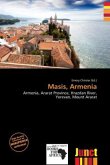High Quality Content by WIKIPEDIA articles! The Armenian Highland shows traces of settlement from the Neolithic era. The Shulaveri-Shomu culture of the central Transcaucasus region is one of the earliest known prehistoric culture in the area, carbon-dated to roughly 6000 - 4000 BC. Another early culture in the area is the Kura-Araxes culture, assigned to the period of ca. 4000 - 2200 BC, succeeded by the Trialeti culture (ca. 2200 - 1500 BC). Armenia lies in the highlands surrounding the Biblical mountains of Ararat, upon which Noah's Ark is said to have come to rest after the flood. (Gen. 8:4). The first excavations in Armenia, undertaken by Russian savants in 1876, brought to light a burial-ground near Dilijan in which were prehistoric graves. Jacques de Morgan in 1887 89 unearthed 576 graves around Alaverdi and Akhatala, on the Tiflis-Alexandropol railway line. Later on, 300 more were discovered by V. Belck near Elisavetpol (Gandzak), and yet others were excavated by Lalayan (second in importance only to de Morgan's) and Ivanovski.
Bitte wählen Sie Ihr Anliegen aus.
Rechnungen
Retourenschein anfordern
Bestellstatus
Storno








